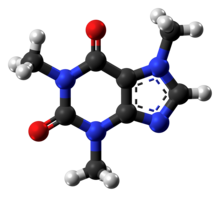**Uses and Effects of Caffeine**:
– Used for prevention and treatment of bronchopulmonary dysplasia in premature infants.
– May improve weight gain, reduce cerebral palsy incidence, and treat apnea of prematurity.
– Used for orthostatic hypotension treatment and some cases of asthma.
– Enhances cognitive and physical performance.
– Improves reaction time, wakefulness, concentration, and motor coordination.
– Delays sleep and improves task performance during sleep deprivation.
– Proven ergogenic aid in humans, enhancing athletic performance in aerobic and anaerobic conditions.
– Increases basal metabolic rate, fat oxidation, and muscular strength, power, and endurance.
**Health Effects and Safety Concerns**:
– Treats premature infant breathing disorders and may protect against Parkinson’s disease.
– Can cause sleep disruption and anxiety in some individuals.
– Mild drug dependence possible with withdrawal symptoms.
– Classified as safe by US FDA at typical doses.
– Toxic dose over 10g/day for adults; safe limits are up to 400mg/day for non-pregnant adults and up to 200mg/day for pregnant and lactating women.
– A cup of coffee contains 80–175mg of caffeine; pure powdered caffeine can be lethal in tablespoon-sized amounts.
– Global consumption: 10 million tonnes of coffee beans consumed globally in 2020.
**Specific Populations and Physiological Effects**:
– Health Canada advises a daily intake of no more than 400mg for healthy adults.
– Children can metabolize caffeine as early as six months old.
– Higher doses can harm children, especially those with psychiatric or cardiac conditions.
– Caffeine affects gastrointestinal motility, gastric acid secretion, and bone loss in postmenopausal women.
– Acute ingestion can stimulate urine output temporarily, with chronic users developing tolerance.
– Dehydration risk may increase with acute intake.
**Psychological Effects, Dependence, and Withdrawal**:
– Common effects include mild anxiety, jitteriness, insomnia, and reduced coordination.
– Can worsen anxiety disorders; high doses can cause or worsen anxiety.
– Caffeine discontinuation may reduce anxiety for some individuals.
– Moderate consumption linked to reduced depression symptoms.
– Withdrawal can cause mild to clinically significant distress or impairment.
– Frequency of self-reported withdrawal is 11% with symptoms of psychological dependence.
**Interactions, Adverse Effects, and Other Considerations**:
– Caffeine interactions with substances and medications.
– Caffeine metabolism changes during pregnancy and breastfeeding.
– Effects on other diseases like Alzheimer’s, liver cirrhosis, type 2 diabetes, and Parkinson’s.
– Energy crash effect post-consumption.
– Overdose symptoms and risks.
– Impact of caffeine in energy drinks and interactions with tobacco, birth control, and medications.
– Pharmacological actions as an adenosine receptor antagonist and chemistry details.
Caffeine is a central nervous system (CNS) stimulant of the methylxanthine class. It is mainly used as a eugeroic (wakefulness promoter) or as a mild cognitive enhancer to increase alertness and attentional performance. Caffeine acts by blocking binding of adenosine to the adenosine A1 receptor, which enhances release of the neurotransmitter acetylcholine. Caffeine has a three-dimensional structure similar to that of adenosine, which allows it to bind and block its receptors. Caffeine also increases cyclic AMP levels through nonselective inhibition of phosphodiesterase.
 | |
 | |
| Clinical data | |
|---|---|
| Pronunciation | /kæˈfiːn, ˈkæfiːn/ |
| Other names | Guaranine Methyltheobromine 1,3,7-Trimethylxanthine 7-methyltheophylline Theine |
| AHFS/Drugs.com | Monograph |
| License data | |
| Pregnancy category |
|
| Dependence liability | Physical: Moderate 13% and variable low–high 10-73% Psychological: Low–moderate |
| Addiction liability | Relatively low: 9% |
| Routes of administration | Common: By mouth Medical: intravenous Uncommon: insufflation, enema, rectal, transdermal, topical |
| Drug class | Stimulant Adenosinergic Eugeroic Nootropic Anxiogenic Analeptic Anorectic Parasympathomimetic Cholinesterase inhibitor Phosphodiesterase inhibitor Diuretic |
| ATC code | |
| Legal status | |
| Legal status |
|
| Pharmacokinetic data | |
| Bioavailability | 99% |
| Protein binding | 10–36% |
| Metabolism | Primary: CYP1A2 Minor: CYP2E1, CYP3A4, CYP2C8, CYP2C9 |
| Metabolites | • Paraxanthine 84% • Theobromine 12% • Theophylline 4% |
| Onset of action | 45 minutes–1 hour |
| Elimination half-life | Adults: 3–7 hours Infants (full term): 8 hours Infants (premature): 100 hours |
| Duration of action | 3–4 hours |
| Excretion | Urine (100%) |
| Identifiers | |
| |
| CAS Number | |
| PubChem CID | |
| IUPHAR/BPS | |
| DrugBank | |
| ChemSpider | |
| UNII | |
| KEGG | |
| ChEBI | |
| ChEMBL | |
| PDB ligand | |
| CompTox Dashboard (EPA) | |
| ECHA InfoCard | 100.000.329 |
| Chemical and physical data | |
| Formula | C8H10N4O2 |
| Molar mass | 194.194 g·mol−1 |
| 3D model (JSmol) | |
| Density | 1.23 g/cm3 |
| Melting point | 235 to 238 °C (455 to 460 °F) (anhydrous) |
| |
| |
| Data page | |
| Caffeine (data page) | |
Caffeine is a bitter, white crystalline purine, a methylxanthine alkaloid, and is chemically related to the adenine and guanine bases of deoxyribonucleic acid (DNA) and ribonucleic acid (RNA). It is found in the seeds, fruits, nuts, or leaves of a number of plants native to Africa, East Asia and South America, and helps to protect them against herbivores and from competition by preventing the germination of nearby seeds, as well as encouraging consumption by select animals such as honey bees. The best-known source of caffeine is the coffee bean, the seed of the Coffea plant. People may drink beverages containing caffeine to relieve or prevent drowsiness and to improve cognitive performance. To make these drinks, caffeine is extracted by steeping the plant product in water, a process called infusion. Caffeine-containing drinks, such as coffee, tea, and cola, are consumed globally in high volumes. In 2020, almost 10 million tonnes of coffee beans were consumed globally. Caffeine is the world's most widely consumed psychoactive drug. Unlike most other psychoactive substances, caffeine remains largely unregulated and legal in nearly all parts of the world. Caffeine is also an outlier as its use is seen as socially acceptable in most cultures and even encouraged in others.
Caffeine has both positive and negative health effects. It can treat and prevent the premature infant breathing disorders bronchopulmonary dysplasia of prematurity and apnea of prematurity. Caffeine citrate is on the WHO Model List of Essential Medicines. It may confer a modest protective effect against some diseases, including Parkinson's disease. Some people experience sleep disruption or anxiety if they consume caffeine, but others show little disturbance. Evidence of a risk during pregnancy is equivocal; some authorities recommend that pregnant women limit caffeine to the equivalent of two cups of coffee per day or less. Caffeine can produce a mild form of drug dependence – associated with withdrawal symptoms such as sleepiness, headache, and irritability – when an individual stops using caffeine after repeated daily intake. Tolerance to the autonomic effects of increased blood pressure and heart rate, and increased urine output, develops with chronic use (i.e., these symptoms become less pronounced or do not occur following consistent use).
Caffeine is classified by the US Food and Drug Administration as generally recognized as safe. Toxic doses, over 10 grams per day for an adult, are much higher than the typical dose of under 500 milligrams per day. The European Food Safety Authority reported that up to 400 mg of caffeine per day (around 5.7 mg/kg of body mass per day) does not raise safety concerns for non-pregnant adults, while intakes up to 200 mg per day for pregnant and lactating women do not raise safety concerns for the fetus or the breast-fed infants. A cup of coffee contains 80–175 mg of caffeine, depending on what "bean" (seed) is used, how it is roasted, and how it is prepared (e.g., drip, percolation, or espresso). Thus it requires roughly 50–100 ordinary cups of coffee to reach the toxic dose. However, pure powdered caffeine, which is available as a dietary supplement, can be lethal in tablespoon-sized amounts.
